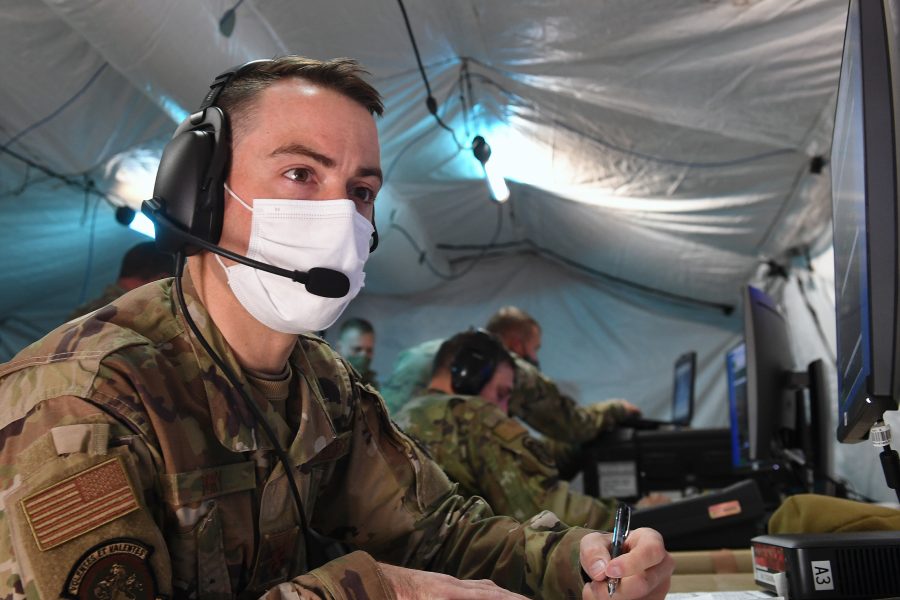Space Force officials are fleshing out the details of a unique approach to military service that combines Active-duty and Reserve commitments, hoping that design will provide more flexibility for families and ultimately keep people in uniform longer.
The service may decide to keep a separate Space National Guard as well, Lt. Gen. Nina M. Armagno, staff director at Space Force headquarters, said during a Feb. 10 Space Foundation event.
“We’re actually working on a dual componency, where instead of having Active, Guard, and Reserve, we have a combined Active and Reserve force, and then potentially a separate space Guard,” she said. “We’re really working on trying to figure out how to recruit the best and retain the best.”
The dual approach could particularly help women in uniform who see a stark choice between starting a family or continuing to serve, among other factors that lead female service members to separate mid-career. As the first armed force created since women were fully integrated into the military, the Space Force is looking to bake in structural measures to boost gender equity from the start.
Nothing is set in stone yet, Armagno cautioned, though Chief of Space Operations Gen. John W. “Jay” Raymond has said the service will propose a new kind of Reserve this year. He told Air Force Magazine last fall he expected the plan to be approved by December 2020, signaling that coming to an agreement on the best force design is proving trickier than anticipated.
“It’s really innovative,” Raymond said of reshaping the typical force structure. “That will require some legislative proposals to make that happen.”
Congress in the fiscal 2021 National Defense Authorization Act fell short of creating a Space Force reserve component, but told the Defense Secretary to send lawmakers his recommendations of how such a plan might work. Capitol Hill also has been skeptical of the need for a Space National Guard, though proponents are quick to note that about 1,500 National Guardsmen now use military space assets for missions like wildfire tracking.
Reservists are already part of the fight as well, handling ballistic missile warning to space weather monitoring during operations and training rotations that last 39 days a year.
The trick is finding the “sweet spot” between full-time and part-time service, Armagno said. Under the dual-track idea, Space Force Guardians may be able to bank time to have a child or finish an educational degree program, she said.
“Other times, life just kind of hits you,” Armagno said. “We want to be able to accommodate the various situations.”
Maj. Gen. DeAnna M. Burt, a top operations official in both the Space Force and U.S. Space Command, said that stability extends to single Guardians as well as those with partners or families. Someone without a spouse or kids shouldn’t be made to move every year, she said, just as the military should find ways to make assignments work for married couples.
She indicated the Space Force may not require a family to relocate while their child is in high school, a move that would avoid uprooting students in their crucial pre-college years.
Those considerations dovetail with the human capital strategy underway in the Space Force’s personnel office. Because the service is so small relative to the rest of the military—it’s expected to grow to 6,700 Active-duty troops this year, compared to the Marine Corps, which has the next-largest Active-duty force at around 181,000 members—leaders see it as a proving ground for better personnel policies.
For one, the Space Force is adjusting to generational differences in how long employees want to stay in one job. Because younger workers are less likely than their parents and grandparents to remain at a single company for decades, the service is reviewing its rules around who can join and when, according to Chief Master Sgt. Amber B. Mitchell, the Space Force’s deputy personnel director.
Other changes in the works include a new approach to promotions and more opportunities for fellowships that let military and space industry employees learn about the other side.
“We still have a lot of work to do to finalize that strategy and fill in some of the blanks,” Raymond said in December. “This will be the most important thing that the Space Force does in the next few months, because it’s going to provide us the means to recruit, attract, assess, develop, and retain a force that we need to be able to operate in space.”


